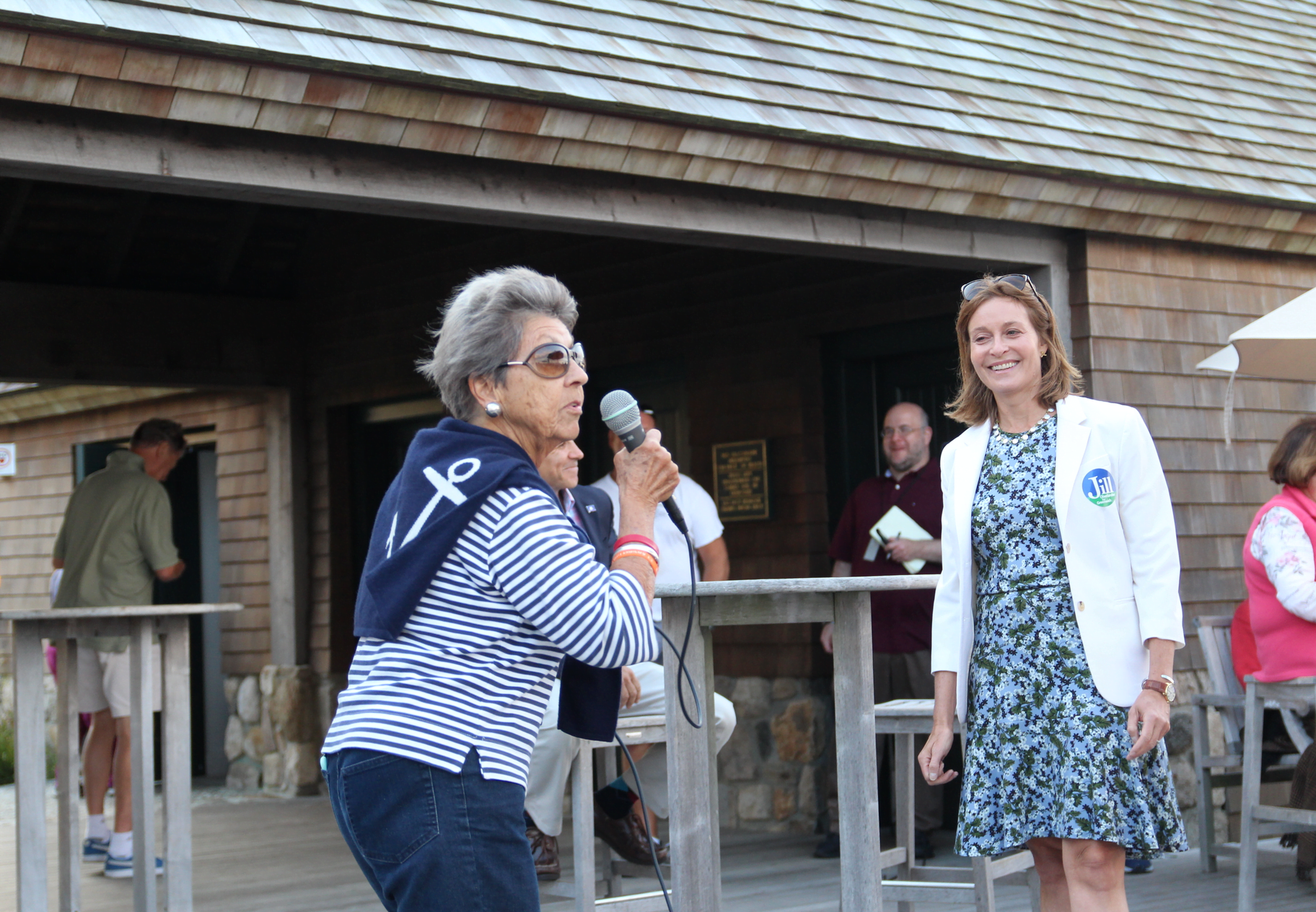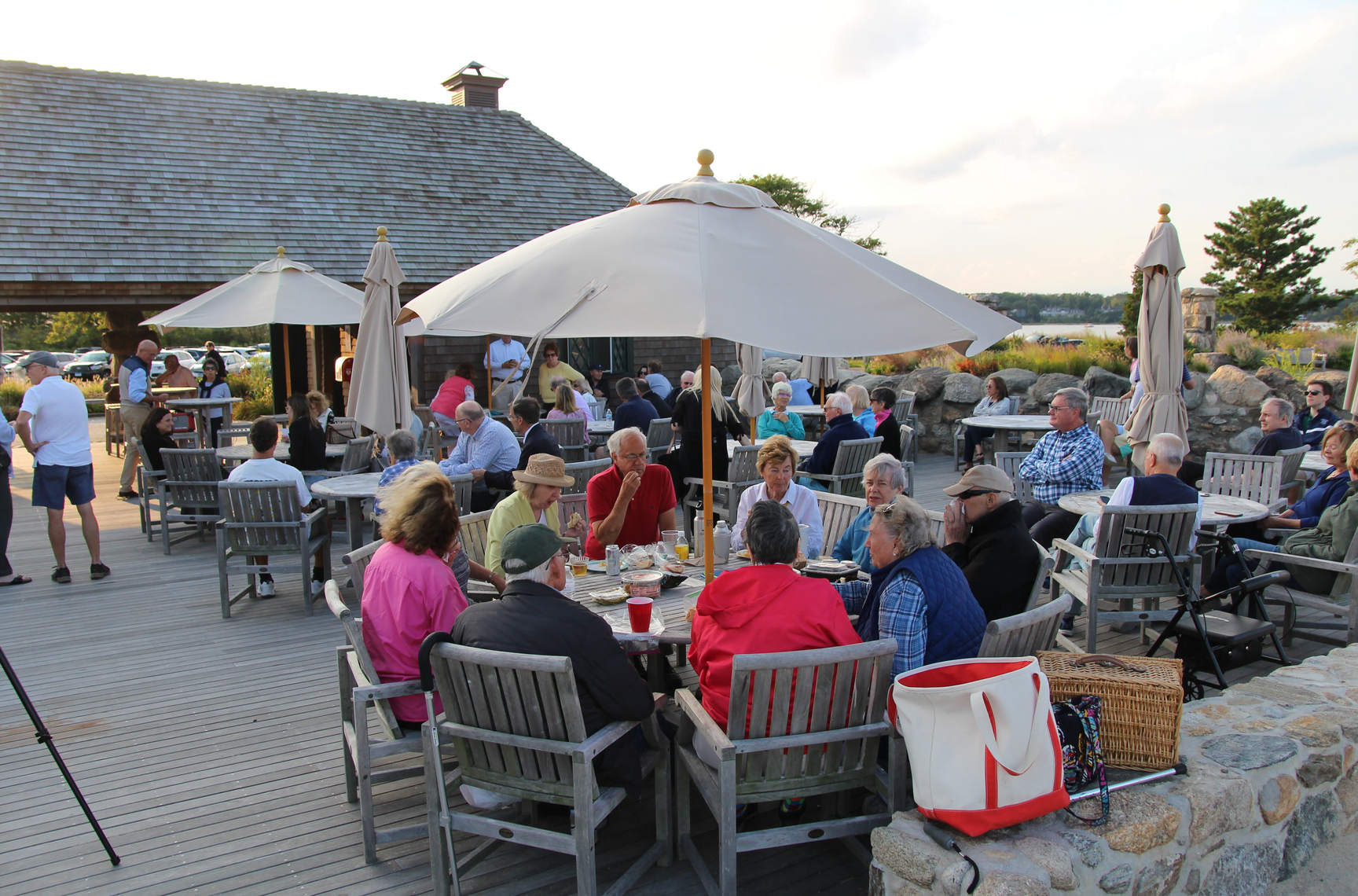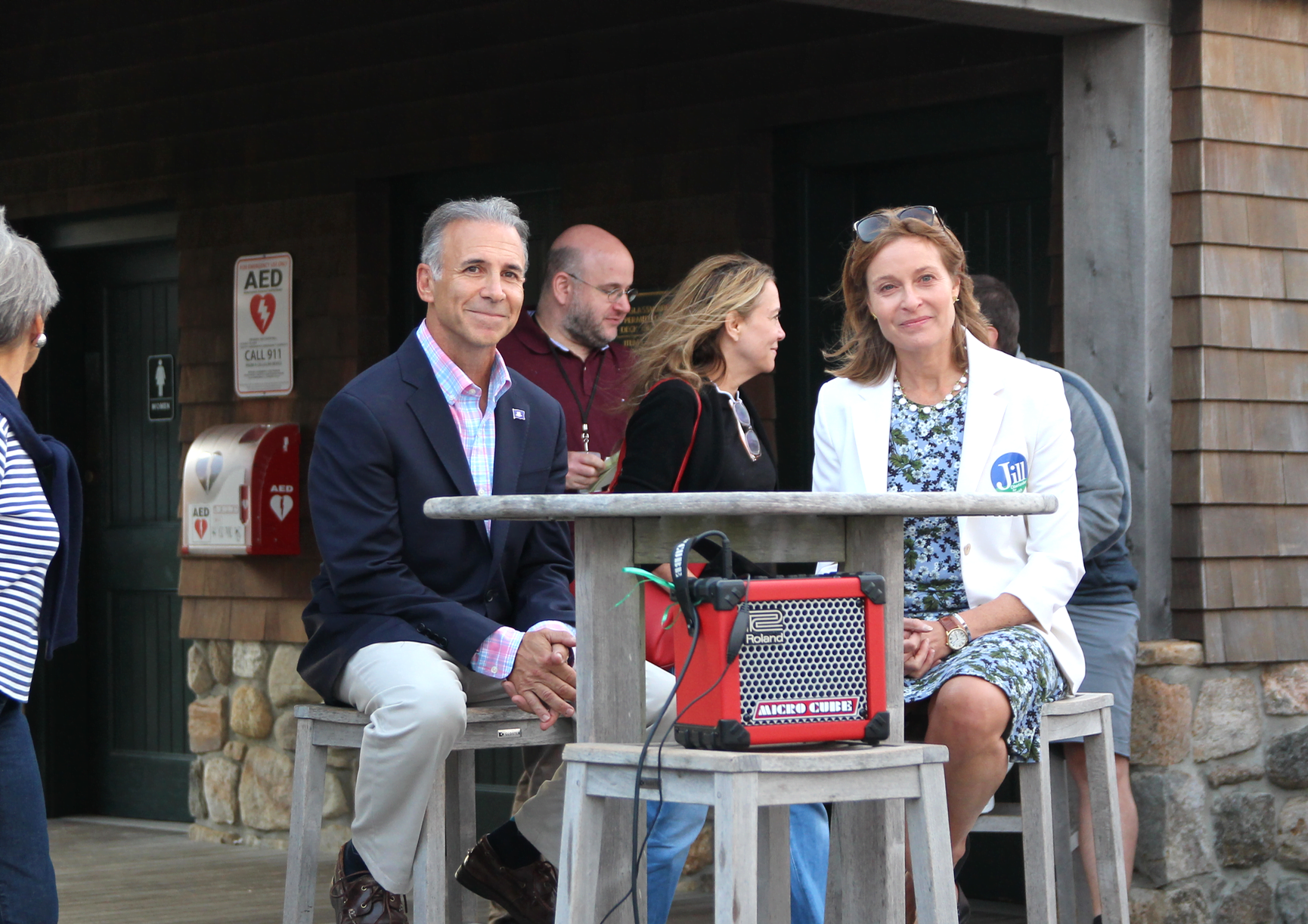About 150 residents turned out for a debate between the candidates for First Selectman Democrat Jill Oberlander and Republican Fred Camillo Monday night.
On the patio at the Susie Baker Pavilion, the town hall format event unfolded as the sun set and seagulls squawked atop the concession stand.
It was the type of beautiful day, complete with glowing sunset, that unites Greenwich residents in their love for Tod’s Point and Long Island Sound.
At one point Ms Baker paused the forum and asked everyone to turn around and behold the three-masted teaching vessel, the schooner Soundwaters as it sailed back to Stamford waters.
Organized by Chris Franco and Susie Baker from the Greenwich Point Conservancy, the event was the first time voters a chance to compare and contrast the candidates side by side.
Baker asked the candidates to introduce themselves.
Oberlander said her platform is “Three E’s” – economy, education and the environment.
“When I started to look into organizations involved in protecting the environment in Greenwich, I stopped counting at 20,” she said.

Oberlander graduated from Cornell University with a degree in Government. Her first job was working for the New York City Parks Dept, followed by a job for the Mayor as an environmental analyst in the Transportation Dept.
She attended law school at University of Chicago and went on to work at different law firms before returning to work in government at the MTA, and then at The Alliance for Downtown NY, a non profit that helped businesses rebound after the 9-11 terrorist attacks.
When Oberlander and her family moved to Greenwich she immediately joined the RTM, where she served for six years.
Currently she is finishing her fourth year on the BET, the last two as chair.
Oberlander pledged to work to enhance sustainability in Greenwich and protect the waterfront.

Mr. Camillo was raised in Cos Cob, and started two environmental related companies. He said he put himself through college and graduate school ten years later.
He has served on many boards and committees in town, and chaired the Parks & Rec Board.
He first ran for state legislature in 2008 and is serving his 6th term as State Rep in the 151st House District.
Camillo said he was proud that in 2015 he supported the Long Island Sound Blue Plan, which he said minimizes conflict and protects resources, and the Climate Change and Coastal Resiliency Bill, an act authorizing municipalities to set up funds to pay for areas damaged by storms.
Camillo emphasized that impacts on the the Town’s interior – tidal ponds, watercourses and in wetlands – have consequences to Long Island Sound, and vice versa. He said he had introduced a preemption law which would have overturned the state law prohibiting a municipality from banning pesticides. Currently CT is one of 20 states where municipalities are not allowed to ban pesticides except for use on town property.
“When you see those yellow signs saying toxic – poison, that winds up here,” Camillo said, pointing to Long Island Sound. “It impacts the fish and some of it ends up in us.”
Camillo emphasized the importance of educating people. “That would be a priority.”
Ms Oberlander agreed the preemption should be overturned and that legislators should continue to advocate for that change.

Camillo said as First Selectman he would create a sustainability and enhancement committee who would report back to him every 30 days.
Oberlander said a committee was not enough. “I hear your conservation committee and I’ll raise you a sustainability plan,” she said, adding her plan would have targets and goals for infrastructure improvements, energy conservation, waste reduction, recycling goals and waterfront protection goals.
Camillo said he didn’t want “to study things to death,” and his committee would not just be “a committee in name.”

Playing Fields: Artificial Turf vs Grass
Dr. Arthur Yee, a neighbor of Central Middle School, asked the candidates where they stood on replacing natural grass playing fields with artificial turf.
Camillo said he loves natural grass and grew up playing on them.
But he said, “I’m someone who also works with many athletic organizations including the Greenwich Athletic Foundation. It (turf) is evolving now. The EPA just put out a report that shows the harmful effects are starting to dissipate.”
Camillo asked that residents keep an open mind. “I’m a health advocate and would rather be safe than sorry. But it’s not the same as if was even five years ago.”
Oberlander said was she preferred natural grass fields, though she said she was aware of the significant demand for playing fields in Greenwich.
“I am an advocate of natural grass. I am a parent first. The health effects for artificial turf are still unknown, particularly for young children and kids with developing minds and bodies,” she said. “We know it’s safer. If we can do natural grass, that’s definitely my preference.”
“A BET member moved to condition the use of artificial turf to take a look at alternatives. We put money in the budget for the Parks Department to do a fields study and understand current fields conditions and demand, and possibilities for engineered grass fields,” she said.
Obelrander said the significant demand for playing fields is the reason Parks & Rec have started initiating proposals for artificial turf.
But she noted costs go “beyond the million dollars for an artificial turf field with a useful life of 10 years.”
Ms Baker said, “Imagine rolling up a whole football field and dumping it in a landfill.”
Energy Conservation, Sustainability and Climate Change
Bob Sims, a member of the Housing Authority board, asked the candidates about electric cars, and energy use. “Climate change is impacting us now,” he said, gesturing to the water.
“We’ve had an energy committee, but they’re not empowered to do anything,” Oberlander said, earning applause when she said she’d look to putting in electric charging stations throughout town.
“People have alternative fuel cars and can’t charge them,” she continued. “There’s no reason we can’t transform our buildings into energy efficient ones – it’s good for bottom line and the environment.”
Camillo said he supported efforts toward alternative energies including solar, geothermal and offshore wind, which he noted Governor Lamont seeks to have account for a third of the state’s energy.
He said small things add up. “More LED lighting in the buildings. Also sensor lights in all the public buildings and solar panels on all our public buildings.”
Dredging
Chris Franco asked the candidates where they stood on dredging.
“Our harbors are silting in,” Franco said. “Are you in support for systematic dredging of harbors and what type of energy could we put behind that?”
Camillo said tidal ponds are also good candidates for dredging, noting that Binney Pond was recently dredged.
“I love marshes. But why would you get rid of salt water?”
He said Mill Pond has never been dredged, and suggested a circulator and fountain that illuminates at night be installed there, funded through a public private partnership.
Camillo also noted that Greenwich Harbor was designated Federal Harbor Refuge in 1948, and the state is talking dredging the navigation channel.
He suggested that through public-private partnerships, the dredge material could be cleaned and used in creative ways.
“You could use private donations to get it cleaned up. You could use that (the dredge material) for other things starting with a Greenwich waterfront district connecting Greenwich Avenue to the waterfront. We have trucks parked there now,” he said, referring to the 1930s Parks Dept utility building.
Camillo said dredge material might also be used for a bridge from Grass Island to Roger Sherman Baldwin Park.
Oberlander said dredging is very expensive and there are many candidates for dredge projects.
“I don’t want to over promise,” she said. “I’m a pragmatist. It’s expensive. We have a lot of projects. All that needs to go into the hopper. We want to protect access to our waterfront, but keep in mind what we can reasonably afford.”
She said if elected she would seek the advice of the Harbor Master and the Harbor Management Commission.

Beach clean up.March 3, 2019 Photo: Leslie Yager
Single Use Plastics Pollution
Julie DesChamps of Skip the Straw said beach cleanups yield large quantities of plastic but are not a solution. She noted Westport is leading the way, banning plastic straws, bags, and plastic food packaging.
She asked the candidates how they would address issue of single use plastics products.
“Change is hard,” Oberlander said, adding that adults are used to the convenience of single use plastics. “But if we show the leadership, our children won’t know the difference.”
Oberlander vowed to work with DesChamps and other advocates. “I’d also raise the challenge: If you bring it in, bring it out with you. We should look to reduce waste especially things that are low cost and sometimes require a change in behaviors.”

Subscribe to the daily Greenwich Free Press newsletter.
Camillo, who previously owned a hauling business and a recycling company, said that most plastic pollution in the ocean doesn’t originate in the US, but leading by example is important.
Historic Overlay and 28 Proposed Homes at Former Mel Gibson Estate
Mike Finkbeiner asked about burdens on water supply and unintended consequences if the proposed subdivision of the former Mel Gibson estate is approved.
Mr. Finkbeiner is a land surveyor who has pressed the Town to address contamination in the area of Western Middle School, Holly Hill (the dump) and Chickahominy, where the Town’s incinerator operated for decades, with runoff from the dump impacting those neighboring properties, Tom’s Brook and Long Island Sound.
“Up Round Hill Road there is no public water supply, and no sewage,” Finkbeiner said.
Referring to the Historic Overlay, a zoning incentive to developers to protect historic properties, Finkbeiner noted the proposal is to develop 28 single family homes, organized as condominiums, on an acre each, without town water or sewer.
He said applying the Historic Overlay for 28 new single family houses would increase density in back country and set a new precedent.
Camillo and Oberlander agreed that the Historic Overlay is a well-intentioned tool for historic preservation, but both expressed concerns about the precedent this proposal would set.
“I am a believer in bringing people to the table for a broader and collaborative conversation,” Oberlander said, adding that many residents believe the First Selectman has more power than he or she actually does. “There are different departments and areas of responsibility. I believe in collaboration, advocacy and compromise,” she said.
Train Station Redevelopment Project
Molly Saleeby, Democratic candidate for Town Clerk, asked the candidates where they stood on the proposed $45 million Greenwich train station redevelopment.
Oberlander said the BET is holding a workshop on the project on Sept 19 at 9:00am in the Mazza room at Town Hall and that the BET is particularly focused on the financial terms of the transaction, and whether the town is getting “the benefit of the bargain” on selling its air rights.
“It’s been done in cities, but not really in Greenwich. It’s a precedent setting transaction,” she said, adding that although the Ashforth Company has been a good partner to the town, the entire project came as something of a surprise.
Renderings were presented on July 9 in the train station lobby at a press conference announced to the media just the night before. Remarks were made by First Selectman Peter Tesei, Ashforth co-CEO Darrell Harvey, Richard Andreski, Connecticut’s Bureau of Public Transportation and Greenwich P&Z director Katie DeLuca.
“It should have been vetted with the public before it was announced as a fait accompli. We should have had a public dialogue. To bring it in and try to push it through doesn’t give respect to citizens about what they want as the gateway to our community. It does not make the trains run faster.” – Jill Oberlander on the proposed Greenwich Railroad Station Redevelopment
Camillo said the project would make the Greenwich train station one of the nicest transportation hubs between Boston and New York.
“It fits in with my earlier proposal about connecting downtown to the water,” he added. “Wait til you see the renderings in a few weeks. You’re going to love it!”
Camillo said the deal for the train station redevelopment with the Town is very complex. “You probably have to bring in heavy outside counsel,” he said.
Oberlander said Ashforth’s lease with the Town for air rights is finite and expires in 40 years. To do a major investment in the train station requires financing. “With the air rights up in the air, the financing becomes a challenge, she said.
“At the end of the lease, the (air rights) portion reverts to the Town. They think it’s a mess and needs to be unraveled. If they want to invest in those buildings, they want to unravel it now.”
Most Pressing Issue for the Town of Greenwich?
Camillo said with revals coming, people moving out of Connecticut, and the SALT deduction cap (the new $10,000 cap on the deductibility of state and property taxes) all hurting home owners, the Town should step up public-private partnerships.
Using the examples of the Greenwich High School’s Cardinal stadium and the Eastern Greenwich Civic Center, he said, “It’s nothing to walk into the Joe Smith Eastern Greenwich Civic Center. It’s done all the time. It’s something we have to do, unless you want to pay triple in your taxes.”

Subscribe to the daily Greenwich Free Press newsletter.
Oberlander said she agreed that maintaining property values and keeping taxes low is the Town’s biggest challenge.
But, she said pushed back on Camillo’s public-private emphasis.
“You can’t outsource government,” she said. “We need smart, professional, effective government.”
“I applaud all members of Town who commit time and resources, including for the new pool, playground and stadium, but government needs to be the primary actor at the table – setting the priorities and being transparent and responsible.”
Future debates:
Thursday, Oct 10, 2019 7-9pm First Selectman and Selectman Debates hosted by the League of Women Voters Greenwich. The debate will be in the Greenwich High School performing arts center at 10 Hillside Rd. There will be two consecutive debates for candidates for First Selectman and Selectman. scheduled to last 75 minutes, the first debate will feature candidates for First Selectman. The Selectman candidates debate will last 45 minutes.
Debates will use the Cumulative Time Format. The public will be invite to submit written questions to the Moderator, Kay Maxwell from Stamford. bi-partisan Screening Committee of League members will screen the questions for relevance and to avoid duplication.
On Wednesday, Oct 30, from 7:00pm to 8:30pm Tax Collector and Town Clerk Debates will also be sponsored by the League of Women Voters Greenwich. Each debate will last 45 minutes. The debate will use a Timed Response Format, with audience questions going directly to the Moderator, Marianne Pollak from Stamford.
The Round Hill Association will also hold a debate between the candidates for First Selectman and Selectman on Tuesday, Oct 22 at the Round Hill Community House at 397 Round Hill Rd. Refreshments are at 6:30. The debate is 7-8:30 pm. Candidates include Fred Camillo, Jill Oberlander, Lauren Rabin, Sandy Litvack. Jara Burnett from LWV will moderate.